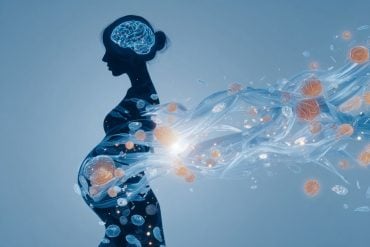Summary: The findings of an EEG study on two-month-old babies reveal the impact of maternal stress on early neurodevelopment.
Source: Children’s Hospital Los Angeles
A study of 70 mothers and their infants suggests that the impact of maternal stress on neurodevelopment is detectable by electroencephalography (EEG) at 2 months of age. The team of investigators, co-led by Pat Levitt, PhD, of Children’s Hospital Los Angeles, and Charles A. Nelson, PhD, of Boston Children’s Hospital, published their findings in JAMA Pediatrics on April 8, 2019.
Early adverse childhood experiences have been shown to impact later learning, behavior and physical health. The prenatal and early-infancy periods are times of particular vulnerability when experiencing early adversity because the brain and other organ systems are undergoing dramatic changes as they mature.
“The ability to detect signs of neurodevelopmental delay at such a young age could provide an opportunity to intervene early by minimizing maternal stress and providing other factors to buffer the impact on the infant,” said Pat Levitt, PhD, Chief Scientific Officer and director of the Saban Research Institute and Simms/Mann Chair in Developmental Neurogenetics at Children’s Hospital Los Angeles.
In partnership with AltaMed Community Health Pediatric clinic in Los Angeles, and a community pediatric practice in Boston, mother and infant pairs were enrolled in the study soon after giving birth. When their infants were 2 months old, mothers filled out questionnaires to indicate their emotional state, recent life events that may have been disruptive, and overall maternal stress by the Perceived Stress Scale.
The goal of the study was to determine risk and resilience factors using different measures of infant neural activity. One technology, electroencephalography (EEG), recorded brain wave activity while the infants viewed random scenes on a video screen. Waveforms on an EEG recording can be categorized into different frequency bandwidths. Each frequency indicates varying amounts of brain circuit activity. The neural networks in infants tend to be simple since the cells and connections are just being formed. As the baby develops, the circuits become more mature and capable of greater information processing.
This increased neural development appears as activity in the gamma frequency of the EEG. The investigators found that increased maternal stress correlated with less gamma frequency activity, indicating delayed development of the brain compared to infants of mothers that reported low stress.
“It’s important to recognize that this was a study of infants seeing their pediatrician for a regular check-up,” said Levitt. “The stressed mothers and the non-stressed mothers shared similar demographics, such as ethnicity, age and family income, yet babies whose mothers reported to be stressed appeared to be less neurologically developed.”
An important finding reported in the article was that higher maternal education, such as high school graduation, may serve as a protective factor to buffer against the stress effect. Babies, whose mothers were under stress but had completed high school or had some college education, exhibited gamma activity indistinguishable from mothers who did not report being stressed.
The initial report conducted at two months of age is part of an ongoing longitudinal study in which the research team is performing measures on the mother-infant pairs at 6, 9, 12, and 24 months of age. They are currently analyzing the data to determine if the changes in brain development are long-lasting or if the infants may catch up over time.

Of note, nearly all of the families enrolled in Los Angeles self-identified their ethnicity as Hispanic and indicated that this was their first opportunity to participate in research. Surveys completed by the mothers showed that this was a positive experience as it allowed them regular interaction with the research team who provided information about typical developmental milestones of their infant and how to access local community resources that may provide additional support for both parent and child.
Funding: Support for this study was provided to Dr. Levitt and Dr. Nelson by the JPB Foundation-funded Research Network on Toxic Stress and Health through the Center on the Developing Child at Harvard University. Additional contributors to the study include first author, Lara J. Pierce, Emily Reilly, Viviane Valdes and Kathleen Conroy of Boston Children’s Hospital; Alma Gharib, Lisa Schlueter and Suzanne Roberts of Children’s Hospital Los Angeles; and Barbara Thompson of Michigan State University. In Los Angeles, research staff members Sandra Figueroa and Juan Ramirez have been instrumental in the success of recruiting families and retaining them in the study.
Source:
Children’s Hospital Los Angeles
Media Contacts:
Ellin Kavanagh – Children’s Hospital Los Angeles
Image Source:
The image is in the public domain.
Original Research: Closed access.
Pierce LJ, Thompson BL, Gharib A, et al. “Association of Perceived Maternal Stress During the Perinatal Period With Electroencephalography Patterns in 2-Month-Old Infants”. JAMA Pediatrics. Published online April 08, 2019. doi:10.1001/jamapediatrics.2019.0492
Abstract
Association of Perceived Maternal Stress During the Perinatal Period With Electroencephalography Patterns in 2-Month-Old Infants
Importance Variation in child responses to adversity creates a clinical challenge to identify children most resilient or susceptible to later risk for disturbances in cognition and health. Advances in establishing scalable biomarkers can lead to early identification and mechanistic understanding of the association of early adversity with neurodevelopment.
Objectives To examine whether maternal reports of stress are associated with patterns in resting electroencephalography at 2 months of age and whether unique electroencephalographic profiles associated with risk and resiliency factors can be identified.
Design, Setting, and Participants For this cohort study, a population-based sample of 113 mother-infant dyads was recruited from January 1, 2016, to March 1, 2018, during regularly scheduled pediatric visits before infants were 2 months of age from 2 primary care clinics in Boston, Massachusetts, and Los Angeles, California, that predominantly serve families from low-income backgrounds. Data are reported from a single time point, when infants were aged 2 months, of an ongoing cohort study longitudinally following the mother-infant dyads.
Exposures Maternal reported exposure to stressful life events and perceived stress.
Main Outcomes and Measures Spectral power (absolute and relative) in different frequency bands (Δ, θ, low and high α, β, and γ) from infant resting electroencephalography (EEG) and EEG profiles across frequency bands determined by latent profile analysis.
Results Of 113 enrolled infants, 70 (mean [SD] age, 2.42 [0.37] months; 35 girls [50%]) provided usable EEG data. In multivariable hierarchical linear regressions, maternal perceived stress was significantly and negatively associated with absolute β (β = −0.007; 95% CI, −0.01 to −0.001; semipartial r = −0.25) and γ power (β = −0.008; 95% CI, −0.01 to −0.002; semipartial r = −0.28). Maternal educational level was significantly and positively associated with power in high α, β, and γ bands after adjusting for covariates (high school: γ: β = 0.108; 95% CI, 0.014-0.203; semipartial r = −0.236; associate’s degree or higher: high α: β = 0.133; 95% CI, 0.018-0.248; semipartial r = 0.241; β: β = 0.167; 95% CI, 0.055-0.279; semipartial r = 0.309; and γ: β = 0.183; 95% CI, 0.066-0.299; semipartial r = 0.323). Latent profile analysis identified 2 unique profiles for absolute and relative power. Maternal perceived stress (β = 0.13; 95% CI, 0.01-0.25; adjusted odds ratio [AOR], 1.14; 95% CI, 1.01-1.28) and maternal educational level (high school: β = 3.00; 95% CI, 0.35-5.65; AOR, 20.09; 95% CI, 1.42-283.16; associate’s degree or higher: β = 4.12; 95% CI, 1.45-6.79; AOR, 61.56; 95% CI, 4.28-885.01) were each associated with unique profile membership.
onclusions and Relevance These findings suggest that unique contributions of caregiver stress and maternal educational level on infant neurodevelopment are detectable at 2 months; EEG might be a promising tool to identify infants most susceptible to parental stress and to reveal mechanisms by which neurodevelopment is associated with adversity. Additional studies validating subgroups across larger cohorts with different stressors and at different ages are required before use at the individual level in clinical settings.






